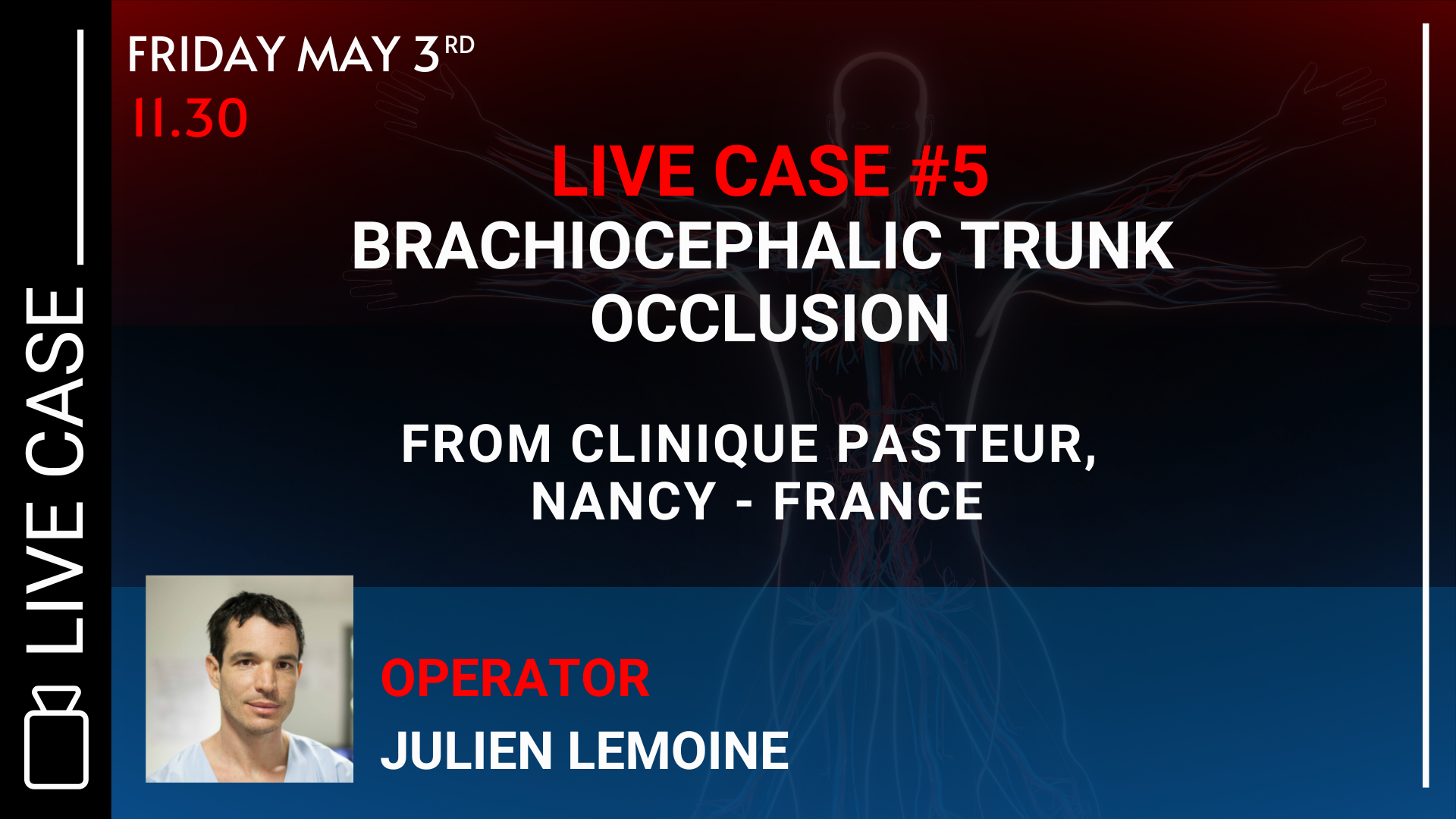×
Il semble que vous utilisiez une version obsolète de internet explorer. Internet explorer n'est plus supporté par Microsoft depuis fin 2015. Nous vous invitons à utiliser un navigateur plus récent tel que Firefox, Google Chrome ou Microsoft Edge.
My Player placeholder

Devenez membre d'Incathlab et bénéficiez d'un accès complet !
Vous devez être membre pour accéder aux vidéos Incathlab sans limitation. Inscrivez vous gratuitement en moins d'une minute et accédez à tous les services Incathlab ! Vous avez aussi la possibilité de vous connecter directement avec votre compte facebook ou twitter en cliquant sur login en haut à droite du site.
Inscription Connexion
Inscription Connexion
117086 vues
6F Radial Long Sheath 80 cm Catheter (TERUMO)
Genesis Stent (Cordis J&J)
Date du tournage : 29/03/2006
Dernière mise à jour : 08/06/2021
Dernière mise à jour : 08/06/2021
Participer à la discussion
Suggestions
Mardi 26 mars 2024 de 18h à 19h30 (GMT+1)
Honolulu : Mardi 26 mars 2024 de 06h à 07h30 (GMT+1)
San Francisco : Mardi 26 mars 2024 de 08h à 09h30 (GMT+1)
New York : Mardi 26 mars 2024 de 11h à 12h30 (GMT+1)
Buenos Aires : Mardi 26 mars 2024 de 13h à 14h30 (GMT+1)
London / Dublin : Mardi 26 mars 2024 de 16h à 17h30 (GMT+1)
Paris / Berlin : Mardi 26 mars 2024 de 17h à 18h30 (GMT+1)
Istanbul : Mardi 26 mars 2024 de 18h à 19h30 (GMT+1)
Moscou / Dubaï : Mardi 26 mars 2024 de 20h à 21h30 (GMT+1)
Bangkok : Mardi 26 mars 2024 de 23h à 00h30 (GMT+1)
Shanghai : Mercredi 27 mars 2024 de 00h à 01h30 (GMT+1)
Tokyo : Mercredi 27 mars 2024 de 01h à 02h30 (GMT+1)
Sydney : Mercredi 27 mars 2024 de 02h à 03h30 (GMT+1)
Wellington : Mercredi 27 mars 2024 de 04h à 05h30 (GMT+1)
San Francisco : Mardi 26 mars 2024 de 08h à 09h30 (GMT+1)
New York : Mardi 26 mars 2024 de 11h à 12h30 (GMT+1)
Buenos Aires : Mardi 26 mars 2024 de 13h à 14h30 (GMT+1)
London / Dublin : Mardi 26 mars 2024 de 16h à 17h30 (GMT+1)
Paris / Berlin : Mardi 26 mars 2024 de 17h à 18h30 (GMT+1)
Istanbul : Mardi 26 mars 2024 de 18h à 19h30 (GMT+1)
Moscou / Dubaï : Mardi 26 mars 2024 de 20h à 21h30 (GMT+1)
Bangkok : Mardi 26 mars 2024 de 23h à 00h30 (GMT+1)
Shanghai : Mercredi 27 mars 2024 de 00h à 01h30 (GMT+1)
Tokyo : Mercredi 27 mars 2024 de 01h à 02h30 (GMT+1)
Sydney : Mercredi 27 mars 2024 de 02h à 03h30 (GMT+1)
Wellington : Mercredi 27 mars 2024 de 04h à 05h30 (GMT+1)
CAS e-Contest Final Results
an interactive european contest on carotid artery stenting
Partager
Discover your Monthly Case
Honolulu : Dimanche 17 septembre 2023 de 21h07 à 21h07 (GMT+2)
San Francisco : Lundi 18 septembre 2023 de 00h07 à 00h07 (GMT+2)
New York : Lundi 18 septembre 2023 de 03h07 à 03h07 (GMT+2)
Buenos Aires : Lundi 18 septembre 2023 de 04h07 à 04h07 (GMT+2)
Reykjavik : Lundi 18 septembre 2023 de 07h07 à 07h07 (GMT+2)
London / Dublin : Lundi 18 septembre 2023 de 08h07 à 08h07 (GMT+2)
Paris / Berlin : Lundi 18 septembre 2023 de 09h07 à 09h07 (GMT+2)
Istanbul : Lundi 18 septembre 2023 de 10h07 à 10h07 (GMT+2)
Moscou / Dubaï : Lundi 18 septembre 2023 de 11h07 à 11h07 (GMT+2)
Bangkok : Lundi 18 septembre 2023 de 14h07 à 14h07 (GMT+2)
Shanghai : Lundi 18 septembre 2023 de 15h07 à 15h07 (GMT+2)
Tokyo : Lundi 18 septembre 2023 de 16h07 à 16h07 (GMT+2)
Sydney : Lundi 18 septembre 2023 de 18h07 à 18h07 (GMT+2)
Wellington : Lundi 18 septembre 2023 de 20h07 à 20h07 (GMT+2)
San Francisco : Lundi 18 septembre 2023 de 00h07 à 00h07 (GMT+2)
New York : Lundi 18 septembre 2023 de 03h07 à 03h07 (GMT+2)
Buenos Aires : Lundi 18 septembre 2023 de 04h07 à 04h07 (GMT+2)
Reykjavik : Lundi 18 septembre 2023 de 07h07 à 07h07 (GMT+2)
London / Dublin : Lundi 18 septembre 2023 de 08h07 à 08h07 (GMT+2)
Paris / Berlin : Lundi 18 septembre 2023 de 09h07 à 09h07 (GMT+2)
Istanbul : Lundi 18 septembre 2023 de 10h07 à 10h07 (GMT+2)
Moscou / Dubaï : Lundi 18 septembre 2023 de 11h07 à 11h07 (GMT+2)
Bangkok : Lundi 18 septembre 2023 de 14h07 à 14h07 (GMT+2)
Shanghai : Lundi 18 septembre 2023 de 15h07 à 15h07 (GMT+2)
Tokyo : Lundi 18 septembre 2023 de 16h07 à 16h07 (GMT+2)
Sydney : Lundi 18 septembre 2023 de 18h07 à 18h07 (GMT+2)
Wellington : Lundi 18 septembre 2023 de 20h07 à 20h07 (GMT+2)
Complex multivascular patient with occluded brachiocephalic trunk
Case of the month: September 2023
Partager
Lundi 10 février 2025 de 17h à 18h (GMT+1)
Honolulu : Lundi 10 février 2025 de 05h à 06h (GMT+1)
San Francisco : Lundi 10 février 2025 de 07h à 08h (GMT+1)
New York : Lundi 10 février 2025 de 10h à 11h (GMT+1)
Buenos Aires : Lundi 10 février 2025 de 12h à 13h (GMT+1)
London / Dublin : Lundi 10 février 2025 de 15h à 16h (GMT+1)
Paris / Berlin : Lundi 10 février 2025 de 16h à 17h (GMT+1)
Istanbul : Lundi 10 février 2025 de 17h à 18h (GMT+1)
Moscou / Dubaï : Lundi 10 février 2025 de 19h à 20h (GMT+1)
Bangkok : Lundi 10 février 2025 de 22h à 23h (GMT+1)
Shanghai : Lundi 10 février 2025 de 23h à 00h (GMT+1)
Tokyo : Mardi 11 février 2025 de 00h à 01h (GMT+1)
Sydney : Mardi 11 février 2025 de 01h à 02h (GMT+1)
Wellington : Mardi 11 février 2025 de 03h à 04h (GMT+1)
San Francisco : Lundi 10 février 2025 de 07h à 08h (GMT+1)
New York : Lundi 10 février 2025 de 10h à 11h (GMT+1)
Buenos Aires : Lundi 10 février 2025 de 12h à 13h (GMT+1)
London / Dublin : Lundi 10 février 2025 de 15h à 16h (GMT+1)
Paris / Berlin : Lundi 10 février 2025 de 16h à 17h (GMT+1)
Istanbul : Lundi 10 février 2025 de 17h à 18h (GMT+1)
Moscou / Dubaï : Lundi 10 février 2025 de 19h à 20h (GMT+1)
Bangkok : Lundi 10 février 2025 de 22h à 23h (GMT+1)
Shanghai : Lundi 10 février 2025 de 23h à 00h (GMT+1)
Tokyo : Mardi 11 février 2025 de 00h à 01h (GMT+1)
Sydney : Mardi 11 février 2025 de 01h à 02h (GMT+1)
Wellington : Mardi 11 février 2025 de 03h à 04h (GMT+1)
Benefits of braided micromesh
Roadsaver TM Insights Week: Celebrating a Decade of CAS Advances
Partager
Mardi 11 février 2025 de 17h à 18h (GMT+1)
Honolulu : Mardi 11 février 2025 de 05h à 06h (GMT+1)
San Francisco : Mardi 11 février 2025 de 07h à 08h (GMT+1)
New York : Mardi 11 février 2025 de 10h à 11h (GMT+1)
Buenos Aires : Mardi 11 février 2025 de 12h à 13h (GMT+1)
London / Dublin : Mardi 11 février 2025 de 15h à 16h (GMT+1)
Paris / Berlin : Mardi 11 février 2025 de 16h à 17h (GMT+1)
Istanbul : Mardi 11 février 2025 de 17h à 18h (GMT+1)
Moscou / Dubaï : Mardi 11 février 2025 de 19h à 20h (GMT+1)
Bangkok : Mardi 11 février 2025 de 22h à 23h (GMT+1)
Shanghai : Mardi 11 février 2025 de 23h à 00h (GMT+1)
Tokyo : Mercredi 12 février 2025 de 00h à 01h (GMT+1)
Sydney : Mercredi 12 février 2025 de 01h à 02h (GMT+1)
Wellington : Mercredi 12 février 2025 de 03h à 04h (GMT+1)
San Francisco : Mardi 11 février 2025 de 07h à 08h (GMT+1)
New York : Mardi 11 février 2025 de 10h à 11h (GMT+1)
Buenos Aires : Mardi 11 février 2025 de 12h à 13h (GMT+1)
London / Dublin : Mardi 11 février 2025 de 15h à 16h (GMT+1)
Paris / Berlin : Mardi 11 février 2025 de 16h à 17h (GMT+1)
Istanbul : Mardi 11 février 2025 de 17h à 18h (GMT+1)
Moscou / Dubaï : Mardi 11 février 2025 de 19h à 20h (GMT+1)
Bangkok : Mardi 11 février 2025 de 22h à 23h (GMT+1)
Shanghai : Mardi 11 février 2025 de 23h à 00h (GMT+1)
Tokyo : Mercredi 12 février 2025 de 00h à 01h (GMT+1)
Sydney : Mercredi 12 février 2025 de 01h à 02h (GMT+1)
Wellington : Mercredi 12 février 2025 de 03h à 04h (GMT+1)
Radial approach benefits in CAS
Roadsaver TM Insights Week: Celebrating a Decade of CAS Advances
Partager
Mercredi 12 février 2025 de 17h à 18h (GMT+1)
Honolulu : Mercredi 12 février 2025 de 05h à 06h (GMT+1)
San Francisco : Mercredi 12 février 2025 de 07h à 08h (GMT+1)
New York : Mercredi 12 février 2025 de 10h à 11h (GMT+1)
Buenos Aires : Mercredi 12 février 2025 de 12h à 13h (GMT+1)
London / Dublin : Mercredi 12 février 2025 de 15h à 16h (GMT+1)
Paris / Berlin : Mercredi 12 février 2025 de 16h à 17h (GMT+1)
Istanbul : Mercredi 12 février 2025 de 17h à 18h (GMT+1)
Moscou / Dubaï : Mercredi 12 février 2025 de 19h à 20h (GMT+1)
Bangkok : Mercredi 12 février 2025 de 22h à 23h (GMT+1)
Shanghai : Mercredi 12 février 2025 de 23h à 00h (GMT+1)
Tokyo : Jeudi 13 février 2025 de 00h à 01h (GMT+1)
Sydney : Jeudi 13 février 2025 de 01h à 02h (GMT+1)
Wellington : Jeudi 13 février 2025 de 03h à 04h (GMT+1)
San Francisco : Mercredi 12 février 2025 de 07h à 08h (GMT+1)
New York : Mercredi 12 février 2025 de 10h à 11h (GMT+1)
Buenos Aires : Mercredi 12 février 2025 de 12h à 13h (GMT+1)
London / Dublin : Mercredi 12 février 2025 de 15h à 16h (GMT+1)
Paris / Berlin : Mercredi 12 février 2025 de 16h à 17h (GMT+1)
Istanbul : Mercredi 12 février 2025 de 17h à 18h (GMT+1)
Moscou / Dubaï : Mercredi 12 février 2025 de 19h à 20h (GMT+1)
Bangkok : Mercredi 12 février 2025 de 22h à 23h (GMT+1)
Shanghai : Mercredi 12 février 2025 de 23h à 00h (GMT+1)
Tokyo : Jeudi 13 février 2025 de 00h à 01h (GMT+1)
Sydney : Jeudi 13 février 2025 de 01h à 02h (GMT+1)
Wellington : Jeudi 13 février 2025 de 03h à 04h (GMT+1)
Complex CAS handling
Roadsaver TM Insights Week: Celebrating a Decade of CAS Advances
Partager
Jeudi 13 février 2025 de 17h à 18h (GMT+1)
Honolulu : Jeudi 13 février 2025 de 05h à 06h (GMT+1)
San Francisco : Jeudi 13 février 2025 de 07h à 08h (GMT+1)
New York : Jeudi 13 février 2025 de 10h à 11h (GMT+1)
Buenos Aires : Jeudi 13 février 2025 de 12h à 13h (GMT+1)
London / Dublin : Jeudi 13 février 2025 de 15h à 16h (GMT+1)
Paris / Berlin : Jeudi 13 février 2025 de 16h à 17h (GMT+1)
Istanbul : Jeudi 13 février 2025 de 17h à 18h (GMT+1)
Moscou / Dubaï : Jeudi 13 février 2025 de 19h à 20h (GMT+1)
Bangkok : Jeudi 13 février 2025 de 22h à 23h (GMT+1)
Shanghai : Jeudi 13 février 2025 de 23h à 00h (GMT+1)
Tokyo : Vendredi 14 février 2025 de 00h à 01h (GMT+1)
Sydney : Vendredi 14 février 2025 de 01h à 02h (GMT+1)
Wellington : Vendredi 14 février 2025 de 03h à 04h (GMT+1)
San Francisco : Jeudi 13 février 2025 de 07h à 08h (GMT+1)
New York : Jeudi 13 février 2025 de 10h à 11h (GMT+1)
Buenos Aires : Jeudi 13 février 2025 de 12h à 13h (GMT+1)
London / Dublin : Jeudi 13 février 2025 de 15h à 16h (GMT+1)
Paris / Berlin : Jeudi 13 février 2025 de 16h à 17h (GMT+1)
Istanbul : Jeudi 13 février 2025 de 17h à 18h (GMT+1)
Moscou / Dubaï : Jeudi 13 février 2025 de 19h à 20h (GMT+1)
Bangkok : Jeudi 13 février 2025 de 22h à 23h (GMT+1)
Shanghai : Jeudi 13 février 2025 de 23h à 00h (GMT+1)
Tokyo : Vendredi 14 février 2025 de 00h à 01h (GMT+1)
Sydney : Vendredi 14 février 2025 de 01h à 02h (GMT+1)
Wellington : Vendredi 14 février 2025 de 03h à 04h (GMT+1)
CAS procedural optimization
Roadsaver TM Insights Week: Celebrating a Decade of CAS Advances
Partager
Vendredi 14 février 2025 de 17h à 18h (GMT+1)
Honolulu : Vendredi 14 février 2025 de 05h à 06h (GMT+1)
San Francisco : Vendredi 14 février 2025 de 07h à 08h (GMT+1)
New York : Vendredi 14 février 2025 de 10h à 11h (GMT+1)
Buenos Aires : Vendredi 14 février 2025 de 12h à 13h (GMT+1)
London / Dublin : Vendredi 14 février 2025 de 15h à 16h (GMT+1)
Paris / Berlin : Vendredi 14 février 2025 de 16h à 17h (GMT+1)
Istanbul : Vendredi 14 février 2025 de 17h à 18h (GMT+1)
Moscou / Dubaï : Vendredi 14 février 2025 de 19h à 20h (GMT+1)
Bangkok : Vendredi 14 février 2025 de 22h à 23h (GMT+1)
Shanghai : Vendredi 14 février 2025 de 23h à 00h (GMT+1)
Tokyo : Samedi 15 février 2025 de 00h à 01h (GMT+1)
Sydney : Samedi 15 février 2025 de 01h à 02h (GMT+1)
Wellington : Samedi 15 février 2025 de 03h à 04h (GMT+1)
San Francisco : Vendredi 14 février 2025 de 07h à 08h (GMT+1)
New York : Vendredi 14 février 2025 de 10h à 11h (GMT+1)
Buenos Aires : Vendredi 14 février 2025 de 12h à 13h (GMT+1)
London / Dublin : Vendredi 14 février 2025 de 15h à 16h (GMT+1)
Paris / Berlin : Vendredi 14 février 2025 de 16h à 17h (GMT+1)
Istanbul : Vendredi 14 février 2025 de 17h à 18h (GMT+1)
Moscou / Dubaï : Vendredi 14 février 2025 de 19h à 20h (GMT+1)
Bangkok : Vendredi 14 février 2025 de 22h à 23h (GMT+1)
Shanghai : Vendredi 14 février 2025 de 23h à 00h (GMT+1)
Tokyo : Samedi 15 février 2025 de 00h à 01h (GMT+1)
Sydney : Samedi 15 février 2025 de 01h à 02h (GMT+1)
Wellington : Samedi 15 février 2025 de 03h à 04h (GMT+1)
CAS, vascular surgeons' perspective
Roadsaver TM Insights Week: Celebrating a Decade of CAS Advances
Partager









Hady L.
I am impressed that you can place a long 6 F sheath in the radial artery which has an outer diamter equivalent to an 8F guiding catheter, without having radial artery spasm or post-procedure occlusion (despite adequate sedation, vasodilators and anticoagulation). The short 6 F Terumo sheaths that we use for coronary interventions don't have this risk because they are very short.
I did not see that you did a radial angiogram before you introduced the long sheath. From your experience, have you had severe radial vasoconstriction specifically in women depsite adequate vasodilation and anticoagulation? What do you recommend if there is a lot of resistance while pulling the long sheath out?
Because of this frequent problem in women I have switched to a brachial approach to treat similar proximal subclavian arteries.
Thank you.
Hady Lichaa, MD
The Greenville clinic
Greenville, Mississippi, USA